For a half-century, the forceful personality and creative intellect of Professor A. Edward Maumenee, MD, dominated U.S. and international ophthalmology. He was a star that illuminated ophthalmic practice, research, and teaching the world over.
Many people considered Dr. Maumenee the most versatile and productive ophthalmologist of the 20th century. With his peaceful death on Jan. 18, 1998, at age 84, that star dimmed. Fortunately, it will never be completely extinguished, because his legacies will continue to exert profound influence. Ophthalmologists, scientists, and patients will continue to benefit from his writings, teachings, and personal examples.
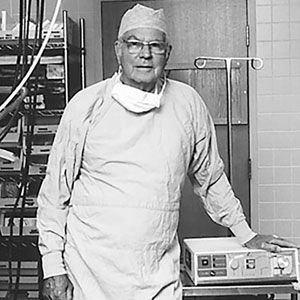
A.E. Maumenee, MD, after another successful eye operation at the Wilmer Eye Institute, approximately 1989.
Idolized throughout the world, “the Prof” was no less a hero in his own institution, the Wilmer Eye Ophthalmological Institute, where his students and colleagues loved, admired, and respected him. He served as director of the Baltimore based institute from 1955 to 1979. In testimony to his accomplishments, an eight-story building and an endowed professorship are named for him at the institute, where so much of his productivity originated and where his portrait is prominently displayed.
Dr. Maumenee’s interests were so diverse and his influence so pervasive that a 1979 “Festschrift” issue of the American Journal of Ophthalmology required eight specialists in various spheres of endeavor to adequately describe his accomplishments. These achievements included the following: initial description of the immunological nature of corneal graft rejection; discovery of new diseases, such as congenital corneal dystrophies; and enhanced methods of surgery for cataract, corneal transplantation, glaucoma filtration, strabismus, congenital glaucoma, congenital cataract, postoperative hypotony, epithelial invasion of the anterior chambers and numerous others.
Moreover, Dr. Maumenee was the first to popularize the clinical use of fluorescein angiography for macular disease, and clearly delineated the major types of macular degeneration well before anyone else considered this an important group of diseases. The number of his articles on these and other subjects exceeds 350, and they clearly have stood the test of time.
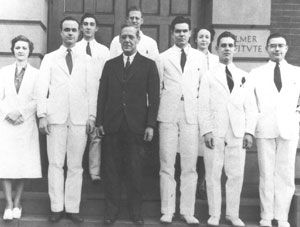
A.E. Maumenee, MD as a resident at the Wilmer Eye Institute. Dr. Maumenee, is pictured at the left side of then Director Dr. Alan Woods, in civilian clothes.
In addition to influencing both choice and technique of surgical intervention through his writings, lectures and teaching courses, Dr. Maumenee regularly welcomed visitors to the Wilmer Eye Institute to watch him operate and to learn at his side. He was a surgical virtuoso, with dazzling technical skills and a calm, confident, and controlled operating room personality.
Patients were referred to him from all over the world, and he invariably gave hope and confidence to even the most desperately sick individuals. Usually, they left Baltimore with improved vision and improved outlooks for the future.
All of us knew Dr. Maumenee was uniquely skilled and gifted. He was a splendid example of an excellent mentor, and he had the ability to bring out the best in his residents, becoming a father figure to many of us.
For complex clinical problems at the Wilmer Institute, we, as residents, always had recourse to Dr. Maumenee. He had, himself, been a resident and chief resident at Wilmer. When he returned to Wilmer after seven years as the Stanford chairman, he was appointed to the faculty as the only full professor of ophthalmology at Johns Hopkins (there are now well over sixty, most of them with endowed professorships). He served as Wilmer’s third director, following Dr. Wilmer – the founder – and Dr. Alan Woods (a uveitis specialist).
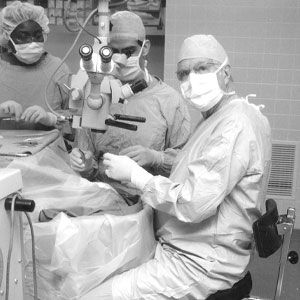
A.E. Maumenee, MD, at the operating microscope, Wilmer Eye Institute, approximately 1989.
The Prof was the greatest! He knew everything and could do everything. He was brilliant at research, teaching, and all aspects of clinical care, including highly complex surgery. He was truly charismatic. He was also unfailingly polite, with typical southern charm, having grown up in Mobile, Ala. and graduated from the University of Alabama. His standard technique was to praise everyone and everything. He would invariably introduce a resident (it didn’t matter which one) to a visitor or to a patient by saying, “This is the best resident I have ever known.”
We never heard Dr. Maumenee say anything critical about Wilmer people, but if he were quiet during a conference, it generally meant he was displeased. He operated on almost every type of disease, and was particularly skilled at cataract extraction, corneal transplants, and goniotomies for children with glaucoma. He had invented several surgical instruments and operative techniques. He knew, more than anyone in the world, the subtleties of congenital glaucoma, epithelial ingrowths, corneal transplant rejections, and many others. He had done extensive personal research and had published definitive articles on these difficult problems. He was a great and multifaceted clinical scholar and as noted earlier, a gifted technical surgeon, as well.
As residents, we had two regular exposures to his fabulous teaching: the Monday morning outpatient conference of difficult and interesting cases, open to the entire staff and to community physicians; and his Thursday morning inpatient rounds for over 60 patients, with only the residents in attendance. These conferences were tours de force. We relished them. We learned an enormous amount from listening to the Prof and, later on, from caring for his patients and operating with him in the Wilmer OR. He was a great role model in virtually all respects. He even looked the part of the Johns Hopkins professor. He was tall, handsome, ingratiating, immaculate, and invariably polite. He always wore a starched, freshly laundered white coat. He never lost his cool … ever. He was naturally charming and gregarious. His highly honed social skills added to his mystique and to his success. All of us wanted to be just like him.
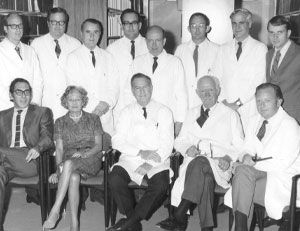
A.E. Maumenee, MD, lower row, seated in middle, with full time faculty at the Wilmer Eye Institute, approximately 1964 (front row seated, L. to R., Arthur Silverstein, PhD, Louise Sloan, PhD, AEM, Frank Walsh, MD, Gunter von Noorden, MD; second row, standing, L. to R., Irvin Pollock, MD, W.R. Green, MD, Maurice Langham, PhD., Keith Green, PhD., Arnall Patz, MD, David Knox, MD, David Paton, MD, and John Dowling, MD, approximately 1967.
The Prof was a “work hard, play hard” guy, and so the residents emulated that lifestyle. He liked to play highly competitive tennis and golf and was an avid duck and goose hunter.
Dr. Maumenee, was committed to meritocracy, regardless of others’ race or religion. He appointed several Jewish doctors to the staff and named the first African American woman, Lois Young, MD, to a clinical fellowship, accomplishing a “first” for both gender and race at Hopkins. The Prof made sure that his all-white private patients had complete exposure to Dr. Young. We were really impressed that he would and could run counter to the prevailing culture in Maryland. He was completely fair in his dealings with other people. He was also the most justifiably self-confident person we have ever known.
The Prof once asked one of us to scrub with him and the chairman of otolaryngology to fix a VIP who had sustained a blow-out fracture of the orbit. Halfway through the case, the two chairmen realized that their resident assistant knew more about the technique and because we had so much more recent personal experience with surgery for trauma than they did. They turned the case over to me, and I took great pleasure in quickly fixing the patient in front of these two world-famous Hopkins specialists.
Dr. Maumenee maintained a leadership role in numerous ophthalmic organizations. He was the first president of the Association of University Professors of Ophthalmology, president of the American Academy of Ophthalmology and Otolaryngology and the Pan-American Association of Ophthalmology, a trustee of the American Journal of Ophthalmology, the international Congress of Ophthalmology, the International Council of Ophthalmology, and the American Ophthalmological Society. He became honorary life president of the International Council of Ophthalmology, an honor bestowed on only two other persons in history: Sir Stewart Duke-Elder of England and Professor Jules Francois of Belgium.
Dr. Maumenee received numerous awards honoring his outstanding contributions to ophthalmology, including the Howe Medal of the American Ophthalmological Society in 1969. He also received the Francis I. Proctor Research Medal (1972) for outstanding research in basic science as applied to ophthalmology, presented by the Association for Research in Vision and Ophthalmology.
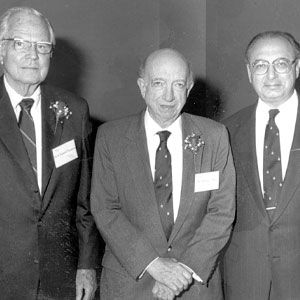
Three consecutive directors of the Wilmer Eye Institute: A.E. Maumenee, MD, Arnall Patz, MD, and Morton F. Goldberg, MD, 1990.
In 1986, he received the International Duke-Elder Medal, an award bestowed by the International Council of Ophthalmology every four years to an ophthalmologist who, by his or her distinction, leadership, and teaching, contributed most to the development of international relations and friendships between ophthalmologists. He was also the recipient of the Gonin Medal and the Pisart Vision Award. He received honorary fellowships or degrees from the Royal College of Surgeons in Edinburgh, Scotland; the University of Illinois; the University of Alabama; and the Technical University of Munich, Germany. Numerous other honors and distinctions are listed in the ophthalmology oral history series published by the American Academy of Ophthalmology.
His efforts in the development of new knowledge and improved quality of care, led to the creation or improvement of numerous organizations, including the Eye Bank Association of America, Tissue Banks International and the Association for Research in Vision and Ophthalmology. In a cooperative effort with Sen. Lister Hill and Jules Stein of Research to Prevent Blindness Inc., Dr. Maumenee was instrumental in the founding of the National Eye Institute at the National Institutes of Health.
When Ed Maumenee died peacefully in his sleep, within hours of enjoying his last game of golf, the world lost one of the most influential, productive and creative ophthalmologists of the 20th century. During the memorial service in his honor near Mobile, Ala., his childhood home, simultaneous eulogies occurred in more than 35 countries.
This uniquely inspirational giant of a man is no longer physically with us but will continue to live in our hearts.
This article was derived from obituaries written by Morton F. Goldberg, MD, Walter J. Stark, MD, and Robert B. Welch, MD.